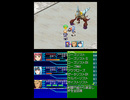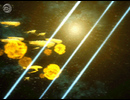|
|

|
PLATFORM
|
DS
|
BATTLE SYSTEM
|

|
INTERACTION
|

|
ORIGINALITY
|

|
STORY
|

|
MUSIC & SOUND
|

|
VISUALS
|

|
CHALLENGE
|
Easy
|
LANGUAGE BARRIER
|
Very High
|
COMPLETION TIME
|
20-40 Hours
|
|
OVERALL

|
+ Battle system is simplified and improved.
+ Game feels very streamlined.
+ Music sounds good through earphones.
- Story to game ratio is unbalanced.
- In-game encyclopedia is needed to get story.
- New mini-games aren't that good.
|
Click here for scoring definitions
|
|
|
I missed out on the original Xenosaga experience back in the day. The character cameos in the Endless Frontier games had always piqued my interest though, and when Mike "JuMeSyn" Moehnke began his massive retro-playthrough of the series I decided to take up the series' oddball title, Xenosaga I + II for the Nintendo DS. Having never played the PS2 titles, I had to confer a lot with other staffers to determine just what was missing or changed.
So, what's missing? A short list would include Xenocards and every other side quest, minigame, and optional boss from the original two games, as well as the Break system in battle, several levels, and an indeterminate number of lesser boss encounters. When compressing two PS2 titles into a single DS cartridge, obviously some changes must be made.
The plot of Xenosaga I + II has suffered the least change, and has actually gained a few more conversations and a new minor character. Large sections of the game have been relegated to sub-story status, however. Sub-stories are optional bits of plot which are activated at specific points in the game. These sub-stories consist only of text and character portraits with the occasional splash page. Many of them provide important background or context for the the current events of the game, and one of them used to be a playable level in the original game (Ziggy's rescue of MOMO from U-TIC). Most if not all of them were apparently non-optional material in the original games, but in the DS iteration it is up to the player to decide if it's worth the time to read through it all. They are all available via the UMN menu at any time, should the player have a change of heart.
Whether one decides to go through all the side-stories, there will still be a lot of reading to do in this game. In fact, it is not inaccurate to say that this game plays more like a visual novel with occasional RPG interludes. As such, the reading level in Japanese is very high, with large numbers of high school kanji in odd combinations. To make things a little easier on the reader, this version has been gifted with a save-anywhere function in lieu of save points, so the player can take a break any time there's a lull in the dialogue.
 There's Gnosis on the starboard bow, starboard bow, starboard bow...
There's Gnosis on the starboard bow, starboard bow, starboard bow...
|
|
The full body of the story plays out like a particularly well-organized season of Star Trek: The Next Generation, complete with cyborgs, bug-eyed aliens, replicant androids, long strings of technobabble, heaps of unobtainium, mirabilis ex machina, and communication faster than the speed of plot. As such things go, it holds together fairly well in the original Japanese, but it's pretty obvious that the writers were aiming to make something more like a novel than a game plot. Much perusal of the in-game encyclopedia is necessary to get the background one needs to understand some of the events over the course of the game. Within the cast of seven characters, three in particular (Shion, Jr., and MOMO) get the most attention in this game, though there are plenty of plot threads left to resolve which involve the other four characters. The game ends with an invitation for the player to continue with Xenosaga Ep. 3, which had not yet been released when this game came out.
After reading through all the commentary about battles attached to Mike "JuMeSyn" Moehnke's Xenosaga Ep. 2 review, and then playing through this game some more, one conclusion can be reached — Monolith scrapped most of the original game's battle system, and improved it in the process. Battles take place on a 5 by 6 grid, split into allied and enemy zones. Over the course of the game Shion will learn new formations which, if the battle characters are positioned in the right way, activate to give important bonuses. Attacks are split between the X button (for projectile attacks) and Y button (for melee attacks). X button attacks can only hit the enemy directly in front of the character, while Y button attacks will hit whichever enemy is currently targeted (by using the L shoulder button to toggle between enemies). Each character has a maximum of three Action Points (AP), though they start with only two AP and regenerate two more per round. With three AP, a character can hit twice and then unleash a special attack. Otherwise, the player can access the item and ether skill (magic) menu by pressing B. Finally, the R shoulder button is used to toggle Boost, which allows allies and enemies to gain extra turns immediately.
 Oh my God, she's dead, Jin! Dead, Jin! Dead, Jin! Dead!
Oh my God, she's dead, Jin! Dead, Jin! Dead, Jin! Dead!
|
|
Eventually (at the start of the Ep. 2 material) the player gets access to the powerful E.S. mecha, which require their own special equipment and restorative items, but otherwise are not too dissimilar in battle from their squishy human pilots. They can only be used in specific levels or on the space lanes around Second Miltia. Their importance to the plot is hinted at several points in the story, but like many other plot threads this is left unresolved until (presumably) the third episode of the series.
As mentioned, the game is a highly condensed version of its PS2 origins. The entirety of the Episode 1 material can be completed in ten to twelve hours, depending on how fast the player can read through it all (if he or she opts to read it at all). The entire game can be wrapped up in twenty hours. As such, the entire gameplay side of Xenosaga I + II has been re-balanced to provide a smoother ride throughout. Bosses without a strong presence in the plotline have largely been eliminated, and several major boss encounters (like the first two or three Margulies battles) have become non-battle plot events. As well, the overall difficulty of the combat has been greatly reduced. Battles are generally short, with one side or the other quickly overpowering their opposition. A few formations in particular, like the one that increases AP or the one that regenerates HP, make later battles far easier than those in the original PS2 titles. Even bosses go down with surprising speed. This game really is a vehicle to showcase its story.
 We come in peace (Shoot to kill, shoot to kill, shoot to kill...)
We come in peace (Shoot to kill, shoot to kill, shoot to kill...)
|
|
Visually, this game resembles the Mega Man Battle Network series more strongly than it does its own source material. They share the same camera angle, same sort of character sprites, and same general color palette. At various points in the game the player is treated to an abbreviated version of one of the PS2 cut-scenes, which are still impressive on a DS screen. All characters and enemies have been rendered as sprites, and there are times where one can see how their work on this game influenced the Monolith devs when they went on to make the Endless Frontier games, especially in terms of space ship bridge design.
A handful of touchscreen minigames have been added, three of which have their own points in the plot where they must be played in order to proceed. None of them are terribly difficult, and they feel tacked on to justify the existence of the lower screen.
One thing that was interesting in this game was its use of a dual experience system. Regular experience just contributes to levels and triggers the learning of special attacks for most characters. The second sort of experience, simply called Points, can be stocked up to invest later in support skills, strengthen and expand ether skills, or increase the effectiveness of special attacks. Raising a special attack to level five allows the player to short-list them, making them two-button combos instead of three so that they can be used far more often in battle.
While this game still uses the occasional moment of silence to punctuate a dramatic moment, most of the time there is musical accompaniment to go with the play experience. The soundtrack has carried over fairly well from the PS2, or at least it sounds like it has. Battles have their fair share of sound effects, including all the characters shouting out attack names or personal taglines like Jr.'s favorite, "Go ahead, make my day."
Playing this title was definitely an interesting experience, and once again I am very happy that I was able to understand as much of the story as I could, given the high symbol count and sometimes creative use of kanji combinations. Whether or not it's a better experience than the original games is harder to say, though again from reading through Mike "JuMeSyn" Moehnke's reviews I can feel safe in saying that in terms of combat it's definitely the more enjoyable game. It's definitely a title that was intended to be read more than played, though it has left me with a strong urge to dig out my PS2, buy a copy of Episode 3, and finish the story. In that, it succeeds as a game.
Review Archives
|









